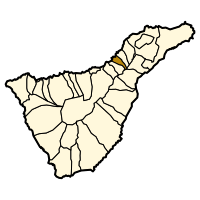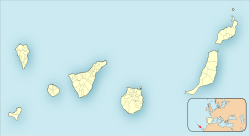La Matanza de Acentejo
La Matanza de Acentejo | |
|---|---|
 Municipal location in Tenerife | |
| Coordinates: 28°27′10″N 16°27′20″W / 28.45278°N 16.45556°W | |
| Country | |
| Autonomous community | |
| Province | |
| Island | |
| Area | |
• Total | 14.11 km2 (5.45 sq mi) |
| Elevation | 425 m (1,394 ft) |
| Population (2018)[2] | |
• Total | 8,956 |
| • Density | 630/km2 (1,600/sq mi) |
| Climate | Csb |
La Matanza de Acentejo is a town near the north coast of Tenerife, Canary Islands, Spain. It is located 10 km east of Puerto de la Cruz, and about 20 km west of the island's capital, Santa Cruz de Tenerife. Its name means "the Slaughter of Acentejo" in Spanish, and refers to the 1494 First Battle of Acentejo, lost by the Spanish.
The population is 8,944 (2013)[3] and the area is 14.11 km2. The elevation is 425 m. The TF-5 motorway passes through the municipality. The municipality contains the following settlements:[3]
- La Matanza de Acentejo
- Guia
- Las Breñas
- El Caleton
- Acentejo
- San Antonio
- San Cristobal
Toponomy
[edit]The municipality takes its name from its administrative capital, which in turn comes from the memory of the battle that took place in this area between Castilians and Guanches during the conquest of the island in the 15th century, in which the latter defeated the former.[4]
Until the reform of the municipal nomenclature in 1916, the municipality was simply called La Matanza. On that date its name was modified to La Matanza de Acentejo. The nickname "de Acentejo" was incorporated into the municipal name to differentiate it from other homonymous towns, being a term of Guanche origin that means 'continuous resonance' according to some researchers.
History
[edit]In historic times before the arrival of the Spaniards, Acentejo was part of the menceyato (kingdom) of Taoro. The first and the second battles of Acentejo took place in 1494. The Spanish under Alonso Fernández de Lugo suffered a terrible defeat at this first battle, at the place now called La Matanza ("The Slaughter"). It occurred in present-day Barranco de San Antonio, which the Guanches called Farfan. The second battle resulted in a victory for the Spaniards, in which the town of La Victoria de Acentejo was founded.
Currently under construction is a scale replica of the interior of the Holy Sepulchre in Jerusalem (the place where according to Christian tradition, was taken the body of Jesus Christ after his crucifixion), the replica will be located in the plaza of El Salvador's municipality. In this room is to also place a replica of the Shroud of Turin (Italy).[5]
Historical population
[edit]| Year | Population |
|---|---|
| 1991 | 5,887 |
| 1996 | 6,451 |
| 2001 | 7,053 |
| 2002 | 7,378 |
| 2003 | 7,490 |
| 2004 | 7,587 |
| 2013 | 8,944 |
Notable people
[edit]- Antonio de Benavides, governor of Spanish Florida
See also
[edit]References
[edit]- ^ a b "SUPERFICIE, PERÍMETRO Y ALTITUD DE LOS MUNICIPIOS DE CANARIAS" (in Spanish). Instituto Canario de Estadística (ISTAC). Archived from the original on 2012-12-04.
- ^ Municipal Register of Spain 2018. National Statistics Institute.
- ^ a b "Población en Canarias. Tenerife. 1-1-2013" (in Spanish). Instituto Canario de Estadística (ISTAC). Archived from the original on 2014-04-18.
- ^ Viera y Clavijo, José de (1950) [1772-1773]. "Tomo III, libro XV". In Elías Serra Ráfols (ed.). Noticias de la historia general de las Islas Canarias (definitiva ed.). Santa Cruz de Tenerife: Goya Ediciones. p. 771.
- ^ La Matanza contará con una réplica del interior del Santo Sepulcro. Noticia del periódico El Día.





